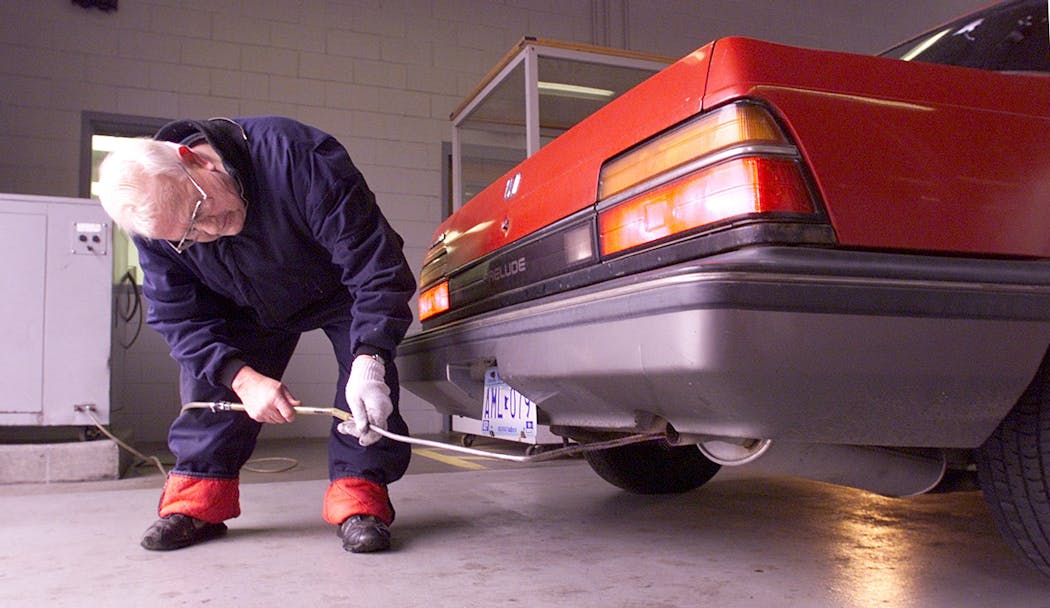Why doesn't Minnesota require vehicle emissions tests any more?
Listen and subscribe to our podcast: Via Apple Podcasts | Spotify | Stitcher
Sam Jasenosky was surprised to learn that her fiancé didn't have take his 2007 Toyota Prius in for an annual emissions inspection as he had in his home state of North Carolina before he moved here.
"I thought 'Why don't we have to take this car in'," she recalled. "I know there would be another level of bureaucracy to go through, but the way we are trying to tackle climate change, it would be a really good idea."
Jasenosky, 26, of South St. Paul, turned to Curious Minnesota, our community-driven reporting project, to find out why Minnesota doesn't require the tests.
Metro area motorists might remember when emissions tests were mandatory.
From 1991 to 1999, drivers had to pay $8 to have their vehicles tested for carbon monoxide and other pollutants before renewing license tabs. The Minnesota Pollution Control Agency (MPCA) instituted the tests after the Environmental Protection Agency (EPA) in Washington, D.C., found carbon monoxide levels in the Twin Cities exceeding federal air quality standards and ordered the state to take action.
In the first month of testing in July 1991, about 20% of vehicles had tailpipe emissions that exceeded limits on hydrocarbons, carbon monoxide or both, said Rocky Sisk, a program administrator for the MPCA. But in the following years, fewer and fewer of the 1.2 million vehicles tested annually failed as older vehicles were taken off the road and replaced with newer ones with better technology.
Cleaner fuel also helped bring down the failure rate, Sisk said.
Within eight years, carbon monoxide levels in the seven-county metro area were compliant with EPA standards and the program was scrapped.
"It was always slated to end when we met carbon monoxide standards," Sisk said. "We put in a plan to reduce carbon monoxide. We reduced them and we didn't need it [the testing] any more."
Aside from freeing up time by taking one task off motorists' to-do lists, eliminating the testing took away a roadblock for drivers who could not afford repairs. Drivers whose vehicles failed could get a waiver for a one-year exemption if fixes cost more than $200, or $75 for vehicles between 1976 and 1980. But they still had to get their vehicles repaired.
"There was a lot of grumbling in the Twin Cities," Sisk said. "It was not a popular program."
Across the country, 31 states plus the District of Columbia currently operate vehicle emission inspection and maintenance programs in at least one area of the state, said Maggie Sauerhage, a spokeswoman for the EPA.
One of the largest is in California, where ground-level ozone creates significant air pollution health threats. Ozone, the main ingredient in smog, is formed when pollutants chemically react in the presence of sunlight. The state instituted its Smog Check Program in 1984 and has "achieved emission reductions needed to meet air quality standards since," said Ben Doci, a spokesman for the California Bureau of Automotive Repair.
Twin Cities carbon monoxide levels have been in compliance with EPA standards for the past 20 years, and "I don't see us going back above them," Sisk said.
In September, Gov. Tim Walz announced Minnesota would be the 15th state to embrace stricter emission standards for cars and trucks. California has taken the lead with fuel-efficiency laws requiring manufacturers to meet escalating mile-per-gallon targets for passenger vehicles through 2025.
Should level carbon monoxide, ozone or other pollutants ever exceed standards of the federal Clean Air Act, vehicle testing could return to Minnesota.
Jasenosky said climate change is one of the biggest issues facing her generation and she believes emissions testing could make people mindful about how pollution impacts the environment.
"This would be something that would at least get on people's radar that they should be more aware of what they are doing," she said. "Whatever I can do in my small part to make it [the climate] better. It all adds up."
---
If you'd like to submit a Curious Minnesota question, fill out the form below:
Read more Curious Minnesota stories:
Why does the Stone Arch Bridge cross the river at such an odd angle?
How did Minnesota become the Gopher State?
Are roundabouts really safer than traditional intersections?
Why do so many Fortune 500 companies call Minnesota home?
Should Minnesota be considered part of the Midwest?
Why are Honeycrisp apples still so expensive?
Why is it so much harder for U students to graduate debt free compared with the 1960s?
How did Minnesota become one of the most racially inequitable states?
What is the best place, time to see northern lights in Minnesota?
Why does everyone love to hate Edina?
How did these 11 Minnesota towns get their unusual names?




